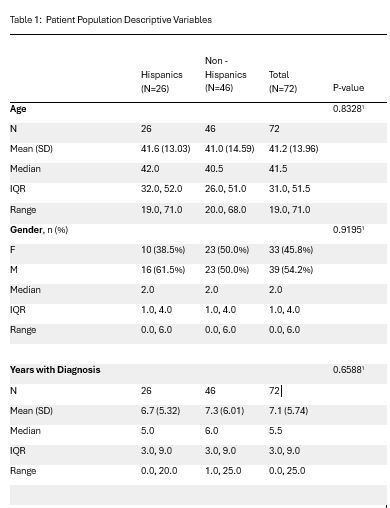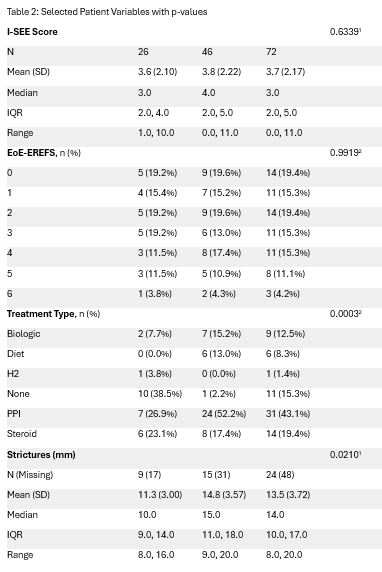Monday Poster Session
Category: Esophagus
P2755 - Comparison of Eosinophilic Esophagitis Disease Severity Based on Hispanic Ethnicity: A Case Control Study
Monday, October 27, 2025
10:30 AM - 4:00 PM PDT
Location: Exhibit Hall

Alejandro J. Gonzalez, MD (he/him/his)
Mayo Clinic School of Graduate Medical Education
Scottsdale, AZ
Presenting Author(s)
Alejandro J. Gonzalez, MD1, Christopher Dodoo, MS2, Benjamin Wright, MD2, Jennifer Horsley-Silva, MD3
1Mayo Clinic School of Graduate Medical Education, Scottsdale, AZ; 2Mayo Clinic, Phoenix, AZ; 3Mayo Clinic Arizona, Scottsdale, AZ
Introduction: Eosinophilic esophagitis (EoE) is a chronic Th2-mediated, allergic disease associated with esophageal eosinophilia and symptoms of esophageal dysfunction. The Index of Severity for Eosinophilic Esophagitis (I-SEE) is a newly developed tool to assess disease severity that is still being validated for clinical use. Previous data suggests that Hispanic patients are diagnosed with EoE less frequently and could have less severe EoE disease then non-Hispanic patients. We compared Hispanic versus non-Hispanic patients using the I-SEE score to evaluate if EoE severity differs according to Hispanic ethnicity.
Methods: We performed a retrospective cohort analysis on patients with a diagnosis of EoE at Mayo Clinic Arizona from 2011-2025 (Table 1). Ethnicity was categorized as: Hispanic or non-Hispanic. Chi-squared test was utilized for categorical variables and the Wilcoxon signed-rank test was utilized for comparison of continuous variables. A multivariate analysis was performed to adjust for potential confounders.
Results: 1,317 patients were identified with our inclusion criteria: 26 Hispanic, 9 Asian, 3 Black, and 1,175 White. 34 White patients were selected by random number generator. On review of I-SEE and EoE-EREFS scores, Hispanics had similar scores. The Hispanic patients were less likely to be on active treatment and more commonly reporting nausea as their predominant symptoms. After multivariate analysis, Hispanic patients had narrower strictures (Table 2).
Discussion: EoE is an emerging disease with the I-SEE score being developed to provide a standardized way to describe disease severity. We aimed to evaluate disease severity in Hispanic patients compared to non-Hispanic patients using the I-SEE score. In this single-center study, we showed that Hispanic and non-Hispanic patients have similar I-SEE and EoE-EREFS scores. Hispanic patients were less likely to be on treatment, had higher eosinophil counts and more severe strictures in comparison to non-Hispanics. Further knowledge is needed to understand barriers to treatment control in Hispanic patients with EoE.

Figure: Table 1: Patient Population Descriptive Variables

Figure: Table 2: Selected Patient Variables with P-value
Disclosures:
Alejandro Gonzalez indicated no relevant financial relationships.
Christopher Dodoo indicated no relevant financial relationships.
Benjamin Wright indicated no relevant financial relationships.
Jennifer Horsley-Silva indicated no relevant financial relationships.
Alejandro J. Gonzalez, MD1, Christopher Dodoo, MS2, Benjamin Wright, MD2, Jennifer Horsley-Silva, MD3. P2755 - Comparison of Eosinophilic Esophagitis Disease Severity Based on Hispanic Ethnicity: A Case Control Study, ACG 2025 Annual Scientific Meeting Abstracts. Phoenix, AZ: American College of Gastroenterology.
1Mayo Clinic School of Graduate Medical Education, Scottsdale, AZ; 2Mayo Clinic, Phoenix, AZ; 3Mayo Clinic Arizona, Scottsdale, AZ
Introduction: Eosinophilic esophagitis (EoE) is a chronic Th2-mediated, allergic disease associated with esophageal eosinophilia and symptoms of esophageal dysfunction. The Index of Severity for Eosinophilic Esophagitis (I-SEE) is a newly developed tool to assess disease severity that is still being validated for clinical use. Previous data suggests that Hispanic patients are diagnosed with EoE less frequently and could have less severe EoE disease then non-Hispanic patients. We compared Hispanic versus non-Hispanic patients using the I-SEE score to evaluate if EoE severity differs according to Hispanic ethnicity.
Methods: We performed a retrospective cohort analysis on patients with a diagnosis of EoE at Mayo Clinic Arizona from 2011-2025 (Table 1). Ethnicity was categorized as: Hispanic or non-Hispanic. Chi-squared test was utilized for categorical variables and the Wilcoxon signed-rank test was utilized for comparison of continuous variables. A multivariate analysis was performed to adjust for potential confounders.
Results: 1,317 patients were identified with our inclusion criteria: 26 Hispanic, 9 Asian, 3 Black, and 1,175 White. 34 White patients were selected by random number generator. On review of I-SEE and EoE-EREFS scores, Hispanics had similar scores. The Hispanic patients were less likely to be on active treatment and more commonly reporting nausea as their predominant symptoms. After multivariate analysis, Hispanic patients had narrower strictures (Table 2).
Discussion: EoE is an emerging disease with the I-SEE score being developed to provide a standardized way to describe disease severity. We aimed to evaluate disease severity in Hispanic patients compared to non-Hispanic patients using the I-SEE score. In this single-center study, we showed that Hispanic and non-Hispanic patients have similar I-SEE and EoE-EREFS scores. Hispanic patients were less likely to be on treatment, had higher eosinophil counts and more severe strictures in comparison to non-Hispanics. Further knowledge is needed to understand barriers to treatment control in Hispanic patients with EoE.

Figure: Table 1: Patient Population Descriptive Variables

Figure: Table 2: Selected Patient Variables with P-value
Disclosures:
Alejandro Gonzalez indicated no relevant financial relationships.
Christopher Dodoo indicated no relevant financial relationships.
Benjamin Wright indicated no relevant financial relationships.
Jennifer Horsley-Silva indicated no relevant financial relationships.
Alejandro J. Gonzalez, MD1, Christopher Dodoo, MS2, Benjamin Wright, MD2, Jennifer Horsley-Silva, MD3. P2755 - Comparison of Eosinophilic Esophagitis Disease Severity Based on Hispanic Ethnicity: A Case Control Study, ACG 2025 Annual Scientific Meeting Abstracts. Phoenix, AZ: American College of Gastroenterology.
